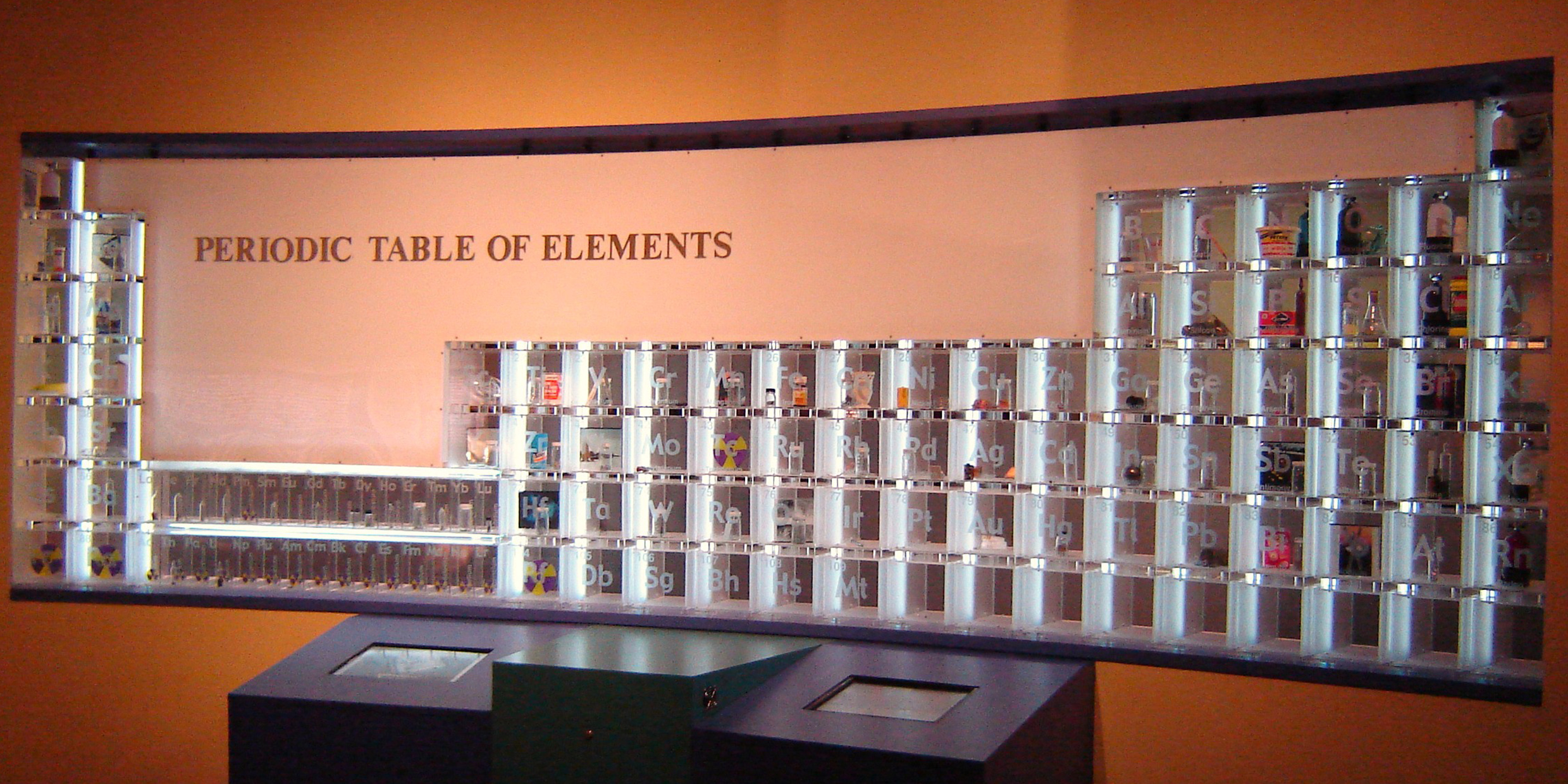Originally published 25 July 1988
Somewhere on the wall of every high school or college chemistry laboratory hangs a periodic table of the elements. Every student of chemistry has an image of the table graven on his brain. I need only close my eyes to summon up the periodic table that hung in my own high school lab — a giant, colorful thing with the symbols of the elements printed in bold black letters on sturdy fabric.
I was not an enthusiastic student of chemistry, but when I looked at the periodic table I knew I was in the presence of some wonderful, fundamental mystery. The way the elements fell into place, in ranks and rows according to their properties — well, it was like music.
Why should the stuff of which the world is made be replete with patterns, harmonies, and cadences? On the left, in column 1, the alkali metals — lithium, sodium, potassium, and their heavier cousins (keep them away from water, our teacher stressed).
On the right, in column 18, the noble gases — helium, neon, argon, krypton, and xenon (safe and sane, completely inert). And bracketed between, like substances neatly arranged on a pharmacist’s shelves, the 92 naturally occurring elements, and a partial row of unstable heavier elements added by those modern alchemists, the nuclear physicists.
What was the magic?
There were puzzles aplenty in the table to intrigue the curious student. Why did the gaseous elements cluster at the upper right of the chart? What was liquid mercury doing down there in the middle of the chart surrounded by solids? Why did copper, silver, and gold, among the few elements known since ancient times, have a column of their own?
In short, what was the magic behind the music? What was the instrument whose tuning made the harmonies? The mysteries were soon unraveled by our teacher, who introduced us to the theory of atomic structure and chemical valency.
It would be hard to describe the excitement that accompanied the realization that the amazing diversity of the world of matter — the reactiveness of the alkalis with water, the inertness of the noble gases, the slipperiness of mercury, the solitariness of gold — all of this and more, could be explained by a theory of almost childlike simplicity.
I recaptured a bit of that excitement a few weeks ago when I purchased a brilliantly-colored, wall-sized periodic table of the elements recently published by Elsevier Science Publishers of the Netherlands. At the center of the chart is a table of the elements similar to the one that hung in my high school lab. In the broad margins of the chart are 20 small versions of the same table, and dozens of color-coded graphs, each one emphasizing some aspect of the music of the elements.
If the periodic table can be likened to music, then this new Elsevier Periodic Table is a symphony. Or perhaps it would be more accurate to say that the periodic table of the elements, here so brilliantly represented by Elsevier, is the score of the symphony which is the world of atoms.
No random things
The person who first transcribed the music of the elements was the Russian chemist Dmitri Ivanovich Mendeleev, in 1869. At that time, 63 elements were known. Mendeleev was something of a dreamer and a philosopher. He was convinced that the elements and their properties were not contrived at random. Behind the apparent chaos of chemistry he sought a pattern. “It is the glory of God to conceal a thing,” he said, “and the honor of kings to search it out.”
Mendeleev wrote the names, atomic weights, and chemical properties of the elements upon 63 cards, and these he arranged into recurring sequences, by atomic weights, like the octaves of the musical scale. He was not the first to look for a pattern within the properties of the elements — the idea was in the air — but he was the first to see the pattern in its entirety.
Within Mendeleev’s arrangement of cards there were three blank spaces, where elements were needed to complete the pattern and none were known. Boldly, Mendeleev predicted the existence of the missing elements, and even suggested their properties. For example, he predicted an element with an atomic weight close to 70, similar to aluminum, easily fusible, able to form alums, and with a volatile chloride. Within a decade just such an element — named gallium — was discovered. So were two other predicted elements — germanium, and scandium — with precisely the properties asserted by Mendeleev. His beautiful arrangement of cards was vindicated.
As I write, my new version of Mendeleev’s table hangs on the wall across the room. It is too far away to read the wealth of graphical and numerical information. But the rhythmic cadences of the graphs and the concert of colors stand out even at a distance — measures and harmonies pleasing to the eye and the mind. It is as Mendeleev guessed: Matter is music!
In 1955, a group of physicists at the University of California in Berkeley announced the discovery of a new element with atomic number 101. Seventeen atoms of the element were artificially created by bombardment of lighter nuclei with the Berkeley cyclotron.
The discovery came at the height of the Soviet-American Cold War. Nevertheless, the Berkeley scientists decided to name the new element for a Russian. Element 101 in the periodic table of the elements became Mendelevium, and, like all other elements discovered since Mendeleev’s day, fell precisely into place in the score of nature, confirming once again the wonderful musicality of matter.



